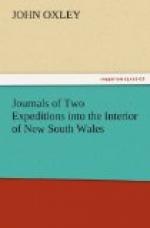April 23.—A fine clear morning. At two o’clock we arrived at Limestone Creek, passing through a beautiful picturesque country of low hills and fine valleys well watered: the timber, as usual of diminutive growth, and unfit for any useful purpose. The ridges of the higher eminences were invariably stony, and about a mile and a half from the Creek, there is a narrow slip of barren country covered with small slate stones: the soil until then was on the sides of the hills of a fine vegetable mould, the more level and lower grounds a hazel-coloured stiff loam, both equally covered with grass, particularly the anthistria. The timber standing at wide intervals, without any brush or undergrowth, gave the country a fine park-like appearance. I never saw a country better adapted for the grazing of all kinds of stock than that we passed over this day. The limestone, which is the first that has hitherto been discovered in Australia, abounds in the valley where we halted; the sides and abrupt projections of the hills being composed entirely of it, and worn by the operation of time into a thousand whimsical shapes and forms. A small stream runs through the valley, which in June 1815 was dry; the bottom of this rivulet was covered with a variety of stones, but the bases of the hills which projected into it, and from which the earth had been washed, were of pure limestone of a bluish grey colour.
April 24.—A fine mild morning. A small piece of limestone which had been put in the fire last night was found perfectly calcined into the purest white lime. At eight o’clock proceeded on our journey, through a very uninteresting but good grazing country: nature here seemed to have assumed her tamest and most unvarying hue. The soil of the country we passed through was generally excellent, but the timber was still as useless as we had hitherto found it. We arrived about one o’clock at a small pond of water, where it was necessary to stop, as there was no other water nearer than the Lachlan River, which was distant about fourteen miles.
April 25.—Our course for the first seven or eight miles was through a level open country, the soil and grass indifferently good. We now ascended a hill a little to the left of the road, for the purpose of viewing the country through which the river ran: it appeared a perfect plain encompassed by moderately high hills, except in the south-east and west quarters, these being apparently the points whence and to which the river flows. The whole country a forest of eucalypti, with occasionally on the banks of the river a space clear of timber: there was nothing either grand or interesting in the view from this hill, neither did I see in any direction such high land as might be expected to give source to a river of magnitude. When we quitted the hill, we went west, to make the Lachlan River, passing for nearly six miles over a perfect level, the land poor, and in places scrubby. At two o’clock saw the river, which certainly




